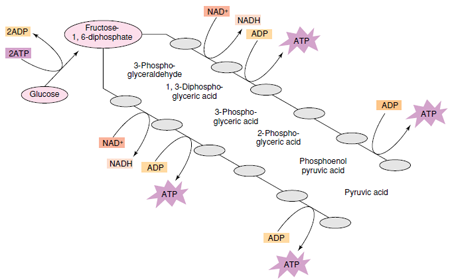Glycolysis
Glycolysis
We begin our journey through the
stages of respiration with glycolysis, a
nearly universal pathway in living
organisms that converts glucose into
pyruvic acid. In a series of reactions,
glucose and other 6-carbon monosaccharides
are split into 3-carbon fragments, pyruvic acid (Figure 4-11). A
single oxidation occurs during glycolysis,
and each molecule of glucose
yields two molecules of ATP. In this
pathway the carbohydrate molecule is
phosphorylated twice by ATP, first to
glucose-6-phosphate (not shown in
Figure 4-11) and then to fructose-1,6-
diphosphate. The fuel has now been
“primed” with phosphate groups in
this uphill portion of glycolysis and is
sufficiently reactive to enable subsequent
reactions to proceed. This is a
kind of deficit financing that is
required for an ultimate energy return
many times greater than the original
energy investment.
In the downhill portion of glycolysis, fructose-1,6-diphosphate is cleaved into two 3-carbon sugars, which undergo an oxidation (electrons are removed), with the electrons and one of the hydrogen ions being accepted by nicotinamide adenine dinucleotide (NAD, a derivative of the vitamin niacin) to produce a reduced form called NADH. NADH serves as a carrier molecule to convey highenergy electrons to the final electron transport chain, where ATP will be produced.
The two 3-carbon sugars next undergo a series of reactions, ending with the formation of two molecules of pyruvic acid (Figure 4-11). In two of these steps, a molecule of ATP is produced. In other words, each 3-carbon sugar yields two ATP molecules, and since there are two 3-carbon sugars, four ATP molecules are generated. Recalling that two ATP molecules were used to prime the glucose initially, the net yield up to this point is two ATP molecules. The 10 enzymatically catalyzed reactions in glycolysis can be summarized as:

 |
| Figure 4-11 Glycolysis. Glucose is phosphorylated in two steps and raised to a higher energy level. High-energy fructose-1,6-diphosphate is split into triose phosphates that are oxidized exergonically to pyruvic acid, yielding ATP and NADH. |
In the downhill portion of glycolysis, fructose-1,6-diphosphate is cleaved into two 3-carbon sugars, which undergo an oxidation (electrons are removed), with the electrons and one of the hydrogen ions being accepted by nicotinamide adenine dinucleotide (NAD, a derivative of the vitamin niacin) to produce a reduced form called NADH. NADH serves as a carrier molecule to convey highenergy electrons to the final electron transport chain, where ATP will be produced.
The two 3-carbon sugars next undergo a series of reactions, ending with the formation of two molecules of pyruvic acid (Figure 4-11). In two of these steps, a molecule of ATP is produced. In other words, each 3-carbon sugar yields two ATP molecules, and since there are two 3-carbon sugars, four ATP molecules are generated. Recalling that two ATP molecules were used to prime the glucose initially, the net yield up to this point is two ATP molecules. The 10 enzymatically catalyzed reactions in glycolysis can be summarized as:




